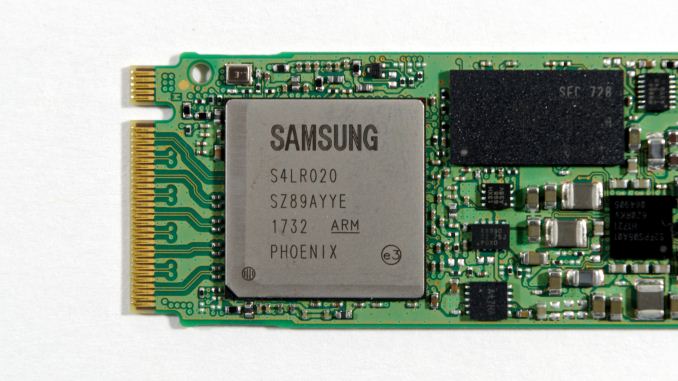The Samsung PM981 SSD Review (512GB, 1TB): Next Generation Controller And 3D NAND
by Billy Tallis on November 30, 2017 9:02 AM ESTConclusions
The Samsung PM981 looks poised to sit as a potential base for a 980 Evo equivalent in 2018. It offers a healthy generational improvement to performance due to the combination of a new controller and Samsung's new 64-layer 3D TLC NAND. The previous generation (PM961 for OEMs, 960 EVO for retail) was already the fastest TLC-based client SSD, and it outperforms many MLC-based SSDs. By improving on that level of performance, the PM981 has caught up to or surpassed the MLC-based 96x drives on many tests, setting new records not just for TLC-based drives but for client SSDs as a whole.
The Samsung PM981 offers performance that is more well-rounded than any other TLC-based SSD. The faster 1TB capacity is almost completely immune to the typical pitfalls of using TLC NAND; it is almost impossible for a real-world workload to trigger the kind of nasty slowdown that typically indicates a full SLC write cache or something else causing a lot of background work for the SSD controller.
The 512GB PM981 doesn't set records except for within its own product class, but it too is a meaningful improvement over its predecessors. The 512GB model doesn't handle heavy workloads quite as well as the larger model, but it still beats any other TLC-based option.
Both drives raise the bar for how well TLC SSDs should perform. On lighter workloads, they set a new standard that even MLC-based drives have trouble reaching. For almost everyone, the fact that the PM981 uses TLC NAND is no cause for concern because the performance defies the expectations for TLC SSDs. They are obviously great choices for OEMs to offer in high-performing notebook computers, depending on the power consumption, which we will test when our testing equipment is fixed.
Enthusiasts will have to wait until CES in January or some later event to hear about Samsung's next SSDs based on the PM981, which is likely to be called the 980 Evo if it follows previous naming conventions. These PM981 drives, if you can source them on the grey market, may be a reasonable choice for impatient system builders wanting to put the latest TLC into their systems today. As always though, OEM drives purchased on the grey market come with no warranty from the manufacturer and firmware updates may be hard to come by, so they aren't for everyone.











53 Comments
View All Comments
msroadkill612 - Sunday, December 31, 2017 - link
Not if you have lane rich TR/Epyc IMO. 2x 512GB 960 proS in raid 0 is 2x~ faster for similar moneymsroadkill612 - Monday, January 1, 2018 - link
It bears noting that each ssd is also a controller, and the samsung one seems very superior kit which may contribute to samsung's scary advantages.Each is a 5x ARM core processor.
msroadkill612 - Monday, January 1, 2018 - link
To be the devils advocate on TLC vs MLC, isn't it odd to second guess samsung?AMD natively demonstrate that raid striping nvme (running them in parallel if u like?), results in ~seamless multiple of raw nvme ssd speeds.
Since current samsung drives individually ~max out the 4x pcie3practical bandwidth available to the m.2 port (~3500MB/s), the ceiling on nvme device speeds currently, is not set by nand, but by IO limitations.
Given multiples of speed can be achieved by raid means , the main issue is not nand chip performance (already dazzlingly fast vs recent storage options), but how to better satisfy insatiable demand using better production.
Personally, I would defer to samsung on that.